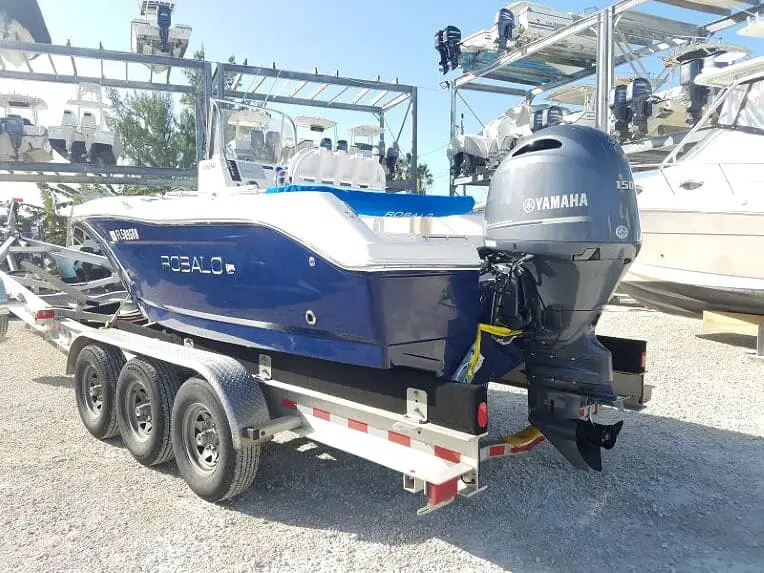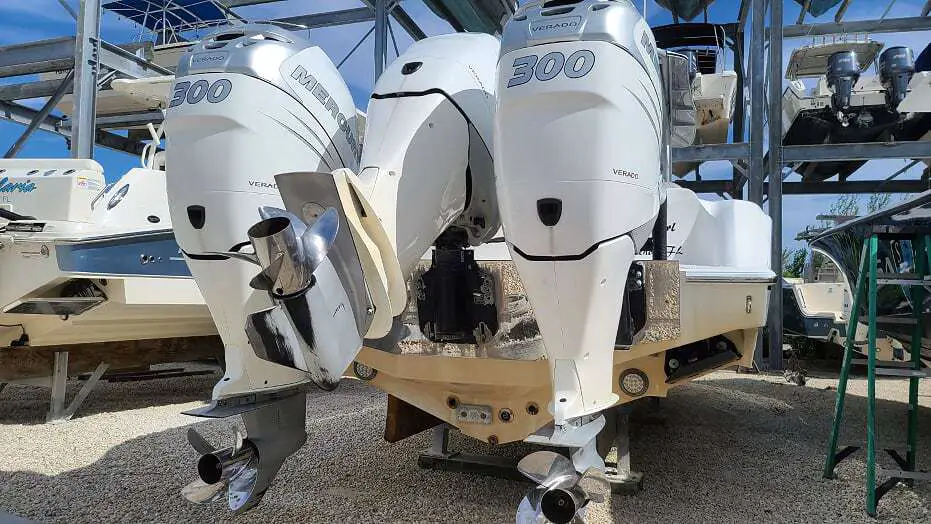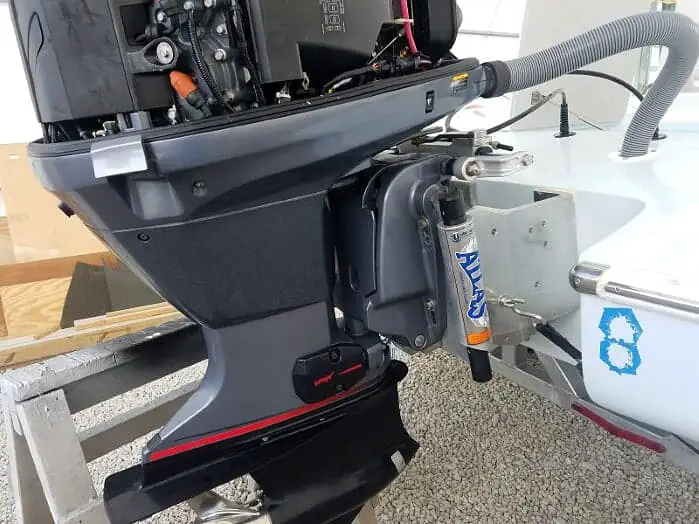As someone that spends a lot of time on the water, you might wonder why boats porpoise. If you’ve been through this experience, you know how scary it can be, and you want quick results.
Why Do Boats Porpoise? A boat can porpoise because the weight in the boat is disproportionate between the bow and the stern. It might also be because of the trim angle of the engine and the mounting height of the engine difference.
We review some of the most common reasons that your boat may porpoise in the water and ways to fix the troublesome issue.
What Exactly is Boat Porpoising or Bouncing?

Have you ever seen a porpoise leap through the water? That same image is what it is like when a powerboat begins to porpoise.
Porpoising is known as a cyclic oscillation of the powerboat in relation to pitch and heave, with sustained or increasing amplitude. It occurs when planning across smooth water.
Basically the bow of the boat just bounces up and down on top of the water.
The severity of boat porpoising can range from a mildly uncomfortable ride to downright dangerous, depending on the conditions.
When the lift is generated at a high trim angle or low dead rise, it leads to an unstable load on all of the lifting surfaces.
Plus, when boats porpoise, there are many dangers to consider. If you lose control over the boat, there is a risk of structural hull damage, payload damage, and injury to the passengers.
At times, the motions can become so severe that the boat tends to dive. It could also stuff, which means that it trips over the bow. When the boat experiences a low trim angle as part of the bow-down cycle, the nose starts to dig in, leading to further damage.
Thankfully, by determining the cause of the porpoising, you can resolve the problem for good.
Why Weight Distribution Causes A Boat To Porpoise.
As with any vessel, adjusting the weight is vital to a smooth and comfortable ride. If your weight is distributed unevenly, you face a higher risk of porpoising on the water.
The distribution of all the people and gear on the boat is vital for this reason. If everyone is standing in the back of the boat. Then the bow is extremely light and the stern is super heavy. Creating the back of the boat to sink in the water, and the bow to stick straight up in the air!
Even the smallest change can trigger your boat to porpoise. Any time that the hull experiences a change to the dynamic balance of forces, there will be residual longitudinal instability.
If you are already operating a boat that is prone to porpoising at a specific velocity, the instability could either make it worse or trigger it to occur sooner.
Ideally, you can alter the dead weight of your boat, such as the payload, battery, and fuel, to accommodate the design of your vessel best. With a little weight distribution, you can create a positive effect on when and where the hump zone occurs.
Like when you take off. If the boat is already back heavy. You can have more people stand in the bow of the boat to get the bow to sit down in the water, then have everyone sit down evenly around the middle of the boat.
Same with the bow being heavy. Have more people come to the middle or back during take off, then evenly distribute after you are on plane.
How The Boat Porpoising Motor Height Relates.
Having a low mounted motor is one of the top reasons that boats begin to porpoise. Thankfully, it’s simple to tell if your motor is at the appropriate mounting height.
The anti-cavitation plate is your indicator in relation to the hull.
Anti-cavitation plates are found on most outboards. These plates are flat and found on the lower unit. While they are essential for boat operation, they also need to be in the right position in order to complete their job.
To check your motor height, look at the anti-cavitation plate. It should ski across the surface of the water whenever the boat is on-plane during operating speed. If it is below the water line, it is going to pull the back of the boat down into the water.
Causing the bow to ride high, and make the boat porpoise once you are at wide open throttle.
There are some other indications that your motor height is too low.
Can’t achieve top-end speed
If you have difficulty reaching your top speed, you might have trouble with the motor height. However, if the boat is new to you, it might be challenging to discern what the highest potential speed actually is.
An incorrect propeller can also cause you to not be able to reach top-end speed as well!
Experience poor handling
If your boat doesn’t handle properly, a low outboard motor might be the cause. Just keep in mind that many other issues can lead to poor handling as well.
Water pushes up to the outboard cowling
If the motor becomes so bogged down, you will see water make its way to the cowling under normal circumstances.
Excessive spray
When the outboard kicks up excessive amounts of water, you are looking at a tell-tale symptom of a motor that’s mounted too low. While it’s okay to experience some spray, it should always be smooth.
How The Engine Trim Setting Makes A Boat Porpoise.

If you want a motorboat that handles its best, you want it to run parallel with the at-rest waterline. Outboards and sterndrives have a power trim adjustment to change the engine’s angle of thrust by tilting it either in or out to maintain a good running angle.
Having the wrong trim angle in either direction can lead to issues.
If you have the angle too far down, it forces the stern of the boat up and leads the bow to drop. This is referred to as plowing and leads to bow steering. Overall, it causes the vee of the bow to dig into the water, leading to difficulty with control.
The boat featuring a thrust angle that’s too far up causes the stern to squat, while the bow rises. This angle leads to problems with forward visibility and hull pounding instead. Plus, either extreme can lead to swamping.
Adjust Engine Trim Settings to Avoid Porpoising
To properly trim a powerboat, you would follow these steps:
- While the engine is in neutral, utilize the trim switch to tilt drive down all the way. Either monitor the trim gauge or pay attention to the tilt motor’s sound, signaling that the engine is trimmed all the way down.
- Place the motor into forward gear and apply throttle until you reach cruising speed. Pay attention to your speedometer.
- Tilt the engine up with the trim switch. The altitude of the boat on the water should change, causing a slight rise to the bow. You might also notice a complete lift of the boat or an increase to the speed.
- Continue lifting until there is a slight drop in speed, the propeller starts to ventilate, or you see a quick rise in the engine RPMs. You don’t want the boat to begin porpoising as a result of the changes.
- Start tilting the engine down slowly until the consistent RPM and maximum speed is reached again. There should be no ventilation noted.
This is when the boat is properly trimmed. Plus, it is now operating at its maximum efficiency when it comes to getting better fuel economy as well!
From here, you can make minor adjustments if you want a more comfortable ride. You might choose to trim the bow down during choppy waters to decrease the wave pounding, but you might experience more spray.
It’s best to experiment and try out different trim functions to see what works best for your boat.

Will a Jack Plate Help With Porpoising?
The jack plate enables the outboard to offer optimum performance while traveling in shallow water. The jack plates lift the motor out of the water higher.
By raising the motor, you receive less drag on the boat and the lower unit. It’s responsible for directing the motor’s thrust parallel to the water. With a high-quality jack plate, the boat is propelled forward with more energy to start, stop, and run across shallow water.
However, there are far better solutions to stop porpoising other than adding a jack plate. We recommend that you continue reading to learn solutions that stop boat porpoising.
Will A Hydrofoil Stop Porpoising?
The hydrofoil provides a performance boost to your vessel. The smaller your boat is, the most of an impact you will see, especially if your boat doesn’t have trim tabs.
Let’s say you have a 16-foot complete with a mid-size outboard and no tabs. The hydrofoil should level out your ride because it forces the stern up and pushes the bow down. Because of this, it could end porpoising.
Additionally, the hydrofoil should offer a two or three mph boost at cruising speeds.
There are also instances that the foils reduce side-to-side rocking with a beam sea.
However, the hydrofoil isn’t necessary to stop the boat’s porpoising. If the hydrofoil does resolve the situation, it’s likely just counterbalancing another problem. Probably, you have a motor that’s simply mounted too low.
How To Stop Boat From Bouncing!
If you don’t want to deal with any boats porpoise, there are some simple solutions. The easiest option is to reduce your speed, but who wants to do that?
Instead, consider these porpoising solutions.
Reduce trim angle
When your boat is porpoising at a certain speed, consider lowering the trim angle, using our directions above. This should completely eliminate or greatly reduce the problem.
Some people feel that it is an unattractive method to correct hull performance, but it will offer you a more comfortable ride in the short term.
Consider changing the trim angle as you drive through the hump zone to keep your vessel under control.
Change static weight location
We discussed weight distribution earlier. By altering the weight balance of your boat, you can affect the trim angle and speed when porpoising begins.
These simple changes also adjust when the hump zone begins to occur.
Clean hull bottom
If you have unplanned rocker or hook in the hull surface, you might notice an exaggerated hump zone performance. By cleaning off the bottom, you solve the porpoise problem.
Change dynamic forces location
By changing the engine setback, propeller selection and motor height, you adjust the dynamic balance of the hull. All of these can have a great effect on the porpoising movement.
By raising the prop shaft higher, you shift the Dynamic Configuration forward and further reduce the trim angle. By changing the setback of the engine, you adjust the balance of the hull during porpoising velocity.
Optimize propeller selection
To change the dynamic balance of the hull, you can adjust the propeller selection and we show you how in this article! As an example, if you make a change to the prop to add more aft-Lift, you effectively alter the dynamic balance of the hull.
This action further changes the range and speed of the hump zone, which should eliminate the porpoising effect.
Trim tabs
By adding trim tabs, you can also improve the porpoise situation. However, these will affect the hull performance as well.
There are also times when adding transom wedges helps because these allow for more negative trim travel.
Consider the design
A higher deadrise hull is less susceptible to porpoising. By choosing a wider planing surface, you can also reduce the instances of porpoising. Consider center-pod surfaces, the vee hull, vee-pad and sponson pads.
Final Thoughts
While it’s never fun to have a boat porpoise, the solutions to the problem are simple enough to implement. By determining what is causing the boat to porpoise, you can find the solution that works best for you.
Check Us Out!
Now that you know all about why a boat porpoises. We encourage you to check us out on our YouTube Channel! Where we create all kinds of helpful how-to and DIY videos to help you learn more and more about your boat and how it works!
You might also find some of these articles here extremely helpful!

